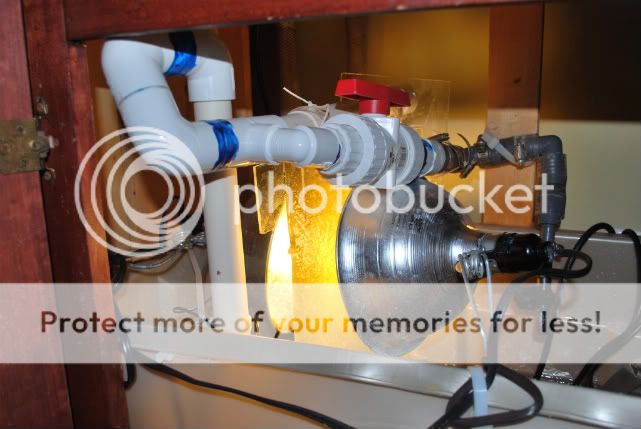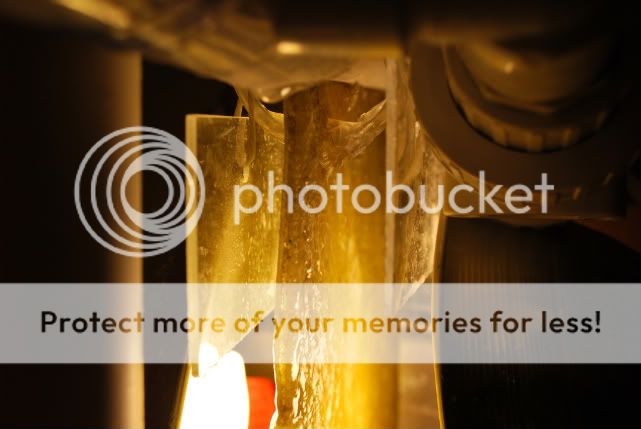I had somebody who was interested in seeing my algal turf scrubber setup, so I'm making this thread, I suppose, to document things a bit. Keep in mind that this is not the first scrubber on this tank. This is actually my 6th iteration, which is how many times it took for me to be satisfied with the design (and not get the surroundings soaking wet). It is also a pretty new scrubber, being only just over 2.5 weeks old. The screen is also new. Anyway, here are the pics, which are followed by any technical details.
Whole Scrubber:

Side Shot (for an idea of growth and flow):

Again, this screen setup is only just over 2.5 weeks old and the screen is also new. I opted for this, because I wanted to start from scratch in terms of roughing the screen as much as possible. I took several days and an hour each session to scratch the surface of the screen. I'm using the same plastic canvas that many are using, except I'm using a smaller grid size (I don't recall the number associated with it). The whole screen is made of 2 plastic canvas grids sandwiched together. It is approximately 9.5" x 11.5" of actual usable surface area on each side(that is, area with algae growing on it), totaling a bit under 220 in^2 of surface area. The total system volume is ~55 gallons, making that almost 4 in^2 of screen per gallon. It's a rough measure/guideline, but it makes for strong filtration from what I've seen.
I'm using my return pump to power the scrubber and that contraption over the side of the scrubber is how I regulate it and disconnect for any major cleanings. I've estimated the total flow at around 700 gph or just shy of it.
You'll also notice the rather odd assortment of 90 degree angles on the left-hand side. That is my flow check in case the scrubber gets clogged for whatever reason. There is enough resistance that water won't flow over and into it normally, but if there is enough resistance to clog the scrubber, it will flow into these 90s. This allows me to avert any disaster that may cause a flood (and yes, if you were wondering, that already happened, lol). I also made a series of acrylic shields to prevent splashing on the lamps. This also slows down growth toward the top of the pipe, making it easy to go without clogging the upper slit between cleanings.
The lighting consists of 2-40w 2700K spiral compact fluorescent bulbs (150w equivalent). It is on for a maximum of 18 hrs per day, with most of the photoperiod coinciding with an unlighted/"dark" display--aka a mostly reverse photoperiod. The bulbs are about 2-3" away from the screen. All light fixtures, bulb/socket interfaces, and portions of the bulbs themselves have been painstakingly siliconed to prevent any entry of liquids and salt, making them almost waterproof. To further prevent disaster, both lamps are zip-tied to the sump itself, completely preventing them from falling, dipping, etc. The bulbs are replaced every 3 mos.
Now, as for my thoughts on the scrubber and its effects, I am somewhat impressed. I am achieving roughly the same kind of results I would have gotten using GFO, but with added nitrate assimilation capabilities. I've been able to feed quite generously (more than with my skimmer alone) without incident. Before, I'd get a noticeable coating of algae shortly after a heavy feeding. With the scrubber and skimmer combo (skimmer is a Deltec APF600), I am able to go nearly 2 weeks between glass cleanings. Something else I've noted that others have as well is that when one parameter begins to become limited, the other rises. For example, once I get phosphate beyond a certain level, I'll get noticeable nitrate rises. A good heavy feeding for a few days will have both levels back down. I am currently maintaining undetectable nitrate concentrations (Salifert) and phosphate concentrations of about .03 (as per a friend's Hanna photometer--Elos kit shows .05-.02). With that, I do intend to continue using this scrubber in the long term to see what it can do. I'm basically just now starting my tank back up again after a long period of neglect and disgust. Things don't look great, but I think they will be on their way. That's why I'm not posting any tank shots, though .
.
Lastly, you may ask why I still run a skimmer. I think they can be handy for several things. In this case, I can get plenty of air equilibration. I'm also able to feed heavily and have the skimmer collect much of the excess (after plugging the return back in) almost immediately, which helps with water quality after the fact. I also dose 2 part, which slowly raises the concentrations of chloride and sodium ions, making sodium chloride and therefore slowly raising the salinity. The skimmer removes salt and helps offset that rise a bit. Lastly, after not running the skimmer for a while, I did have flourishing populations of filter feeders, but at least some of them were highly undesirable (digitate hydroids come to mind). I think the skimmer helps curb those to some degree by removing particulates and at least some food from the water. A worthwhile tradeoff, at least for now.
Hopefully that was pretty exhaustive, but if there are any extra questions, feel free to post them.
Whole Scrubber:

Side Shot (for an idea of growth and flow):

Again, this screen setup is only just over 2.5 weeks old and the screen is also new. I opted for this, because I wanted to start from scratch in terms of roughing the screen as much as possible. I took several days and an hour each session to scratch the surface of the screen. I'm using the same plastic canvas that many are using, except I'm using a smaller grid size (I don't recall the number associated with it). The whole screen is made of 2 plastic canvas grids sandwiched together. It is approximately 9.5" x 11.5" of actual usable surface area on each side(that is, area with algae growing on it), totaling a bit under 220 in^2 of surface area. The total system volume is ~55 gallons, making that almost 4 in^2 of screen per gallon. It's a rough measure/guideline, but it makes for strong filtration from what I've seen.
I'm using my return pump to power the scrubber and that contraption over the side of the scrubber is how I regulate it and disconnect for any major cleanings. I've estimated the total flow at around 700 gph or just shy of it.
You'll also notice the rather odd assortment of 90 degree angles on the left-hand side. That is my flow check in case the scrubber gets clogged for whatever reason. There is enough resistance that water won't flow over and into it normally, but if there is enough resistance to clog the scrubber, it will flow into these 90s. This allows me to avert any disaster that may cause a flood (and yes, if you were wondering, that already happened, lol). I also made a series of acrylic shields to prevent splashing on the lamps. This also slows down growth toward the top of the pipe, making it easy to go without clogging the upper slit between cleanings.
The lighting consists of 2-40w 2700K spiral compact fluorescent bulbs (150w equivalent). It is on for a maximum of 18 hrs per day, with most of the photoperiod coinciding with an unlighted/"dark" display--aka a mostly reverse photoperiod. The bulbs are about 2-3" away from the screen. All light fixtures, bulb/socket interfaces, and portions of the bulbs themselves have been painstakingly siliconed to prevent any entry of liquids and salt, making them almost waterproof. To further prevent disaster, both lamps are zip-tied to the sump itself, completely preventing them from falling, dipping, etc. The bulbs are replaced every 3 mos.
Now, as for my thoughts on the scrubber and its effects, I am somewhat impressed. I am achieving roughly the same kind of results I would have gotten using GFO, but with added nitrate assimilation capabilities. I've been able to feed quite generously (more than with my skimmer alone) without incident. Before, I'd get a noticeable coating of algae shortly after a heavy feeding. With the scrubber and skimmer combo (skimmer is a Deltec APF600), I am able to go nearly 2 weeks between glass cleanings. Something else I've noted that others have as well is that when one parameter begins to become limited, the other rises. For example, once I get phosphate beyond a certain level, I'll get noticeable nitrate rises. A good heavy feeding for a few days will have both levels back down. I am currently maintaining undetectable nitrate concentrations (Salifert) and phosphate concentrations of about .03 (as per a friend's Hanna photometer--Elos kit shows .05-.02). With that, I do intend to continue using this scrubber in the long term to see what it can do. I'm basically just now starting my tank back up again after a long period of neglect and disgust. Things don't look great, but I think they will be on their way. That's why I'm not posting any tank shots, though
Lastly, you may ask why I still run a skimmer. I think they can be handy for several things. In this case, I can get plenty of air equilibration. I'm also able to feed heavily and have the skimmer collect much of the excess (after plugging the return back in) almost immediately, which helps with water quality after the fact. I also dose 2 part, which slowly raises the concentrations of chloride and sodium ions, making sodium chloride and therefore slowly raising the salinity. The skimmer removes salt and helps offset that rise a bit. Lastly, after not running the skimmer for a while, I did have flourishing populations of filter feeders, but at least some of them were highly undesirable (digitate hydroids come to mind). I think the skimmer helps curb those to some degree by removing particulates and at least some food from the water. A worthwhile tradeoff, at least for now.
Hopefully that was pretty exhaustive, but if there are any extra questions, feel free to post them.


